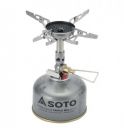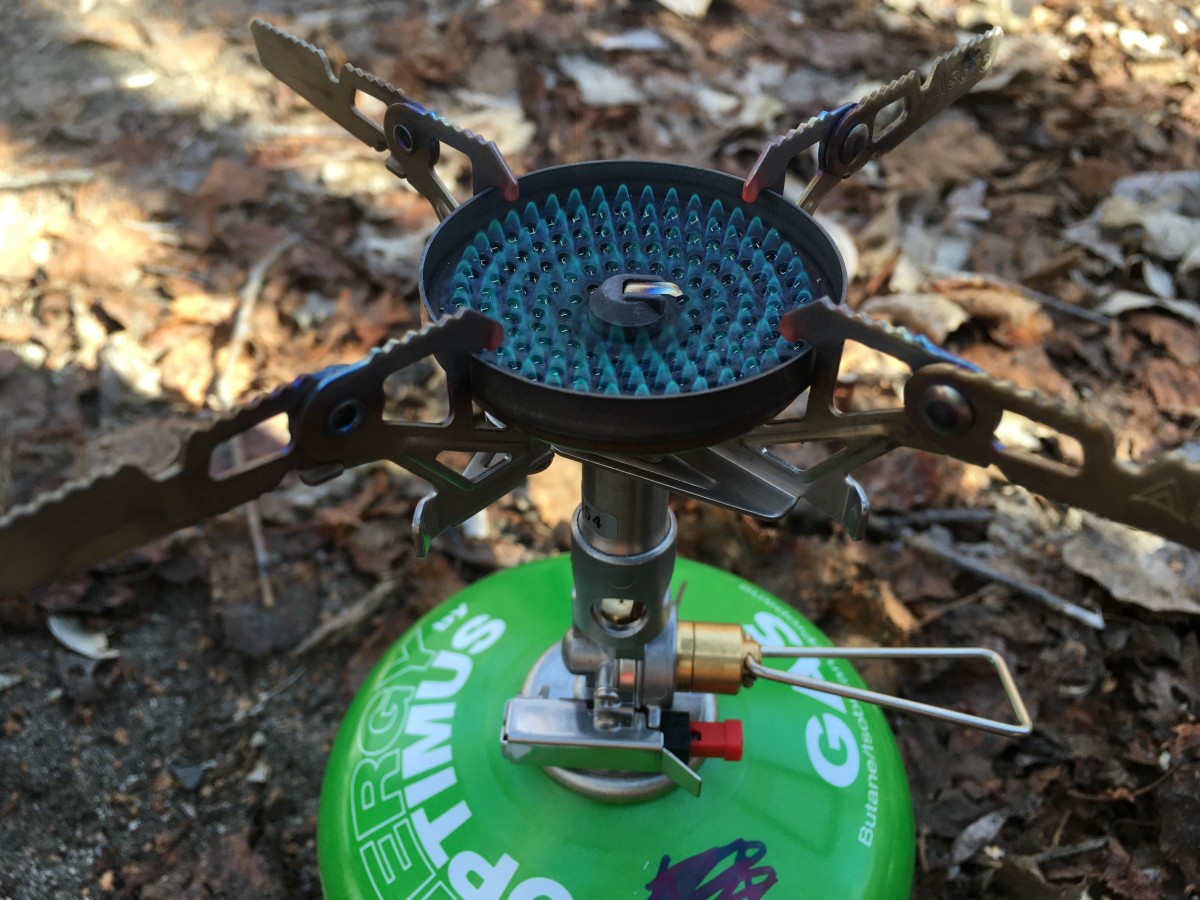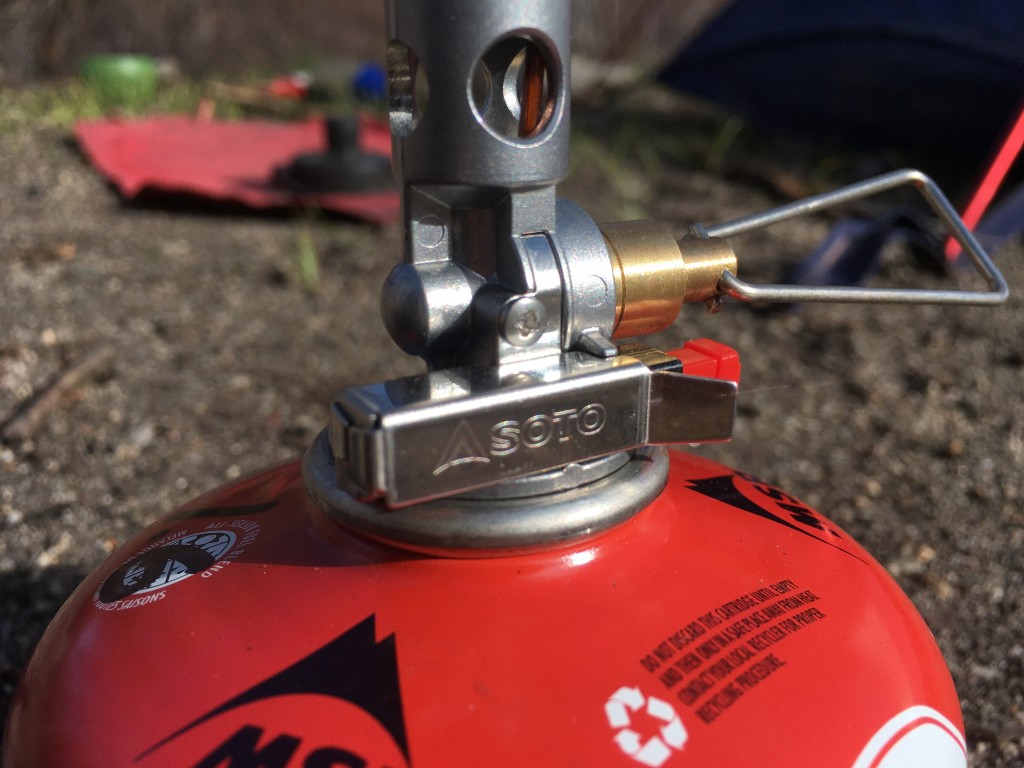Our Verdict
Compare to Similar Products
 This Product
Soto Windmaster | |||||
|---|---|---|---|---|---|
| Awards | Best Overall Backpacking Stove | Best Ultralight Backpacking Stove | High Value and Ultralight | Best on a Tight Budget | |
| Price | $69.95 at REI Compare at 2 sellers | $84.95 at REI Compare at 3 sellers | $50 List $49.95 at Amazon | $30 List $29.95 at Amazon | $17.00 List $16.95 at Amazon |
Overall Score  |
|||||
| Star Rating | |||||
| Bottom Line | This lightweight stove is easy to use and will boil water when it's breezy | A crowd favorite for simmering that works well in a breeze and is also easy to use | This canister stove is lightweight, compact, fuel efficient, and performs well in wind | A bulky small canister stove that's good at simmering but doesn't have a piezoelectric start | A mini stove with a mini price |
| Rating Categories | Soto Windmaster | MSR PocketRocket De... | Soto Amicus | Primus Essential Trail | BRS-3000T |
| Fuel Efficiency (25%) | |||||
| Weight (25%) | |||||
| Simmering Ability (20%) | |||||
| Ease of Use (15%) | |||||
| Boil Time (15%) | |||||
| Specs | Soto Windmaster | MSR PocketRocket De... | Soto Amicus | Primus Essential Trail | BRS-3000T |
| Category | Small Canister | Small Canister | Small Canister | Small Canister | Small Canister |
| Essential Weight (stove or stove + integrated pot only) | 3.0 oz | 3.0 oz | 2.79 oz | 4.5 oz | 0.9 oz |
| Trail Weight (stove, fuel, pot) | 15.63 oz | 15.13 oz | 14.92 oz | 16.63 oz | 12.63 oz |
| Wind Boil Time (1 liter, 2-4mph) | 5:46 min:sec | 5:27 min:sec | 6:30 min:sec | 10:10 min | 14:45 min:sec |
| Boil Time (1 liter) | 4 min:sec | 3:14 min:sec | 3:52 min: sec | 5:30 min:sec | 5:13 min:sec |
| Packed Weight (stove + all accessories) | 3.5 oz | 3.5 oz | 3.5 oz | 4.5 oz | 1 oz |
| Dimensions | 4.7" x 3.9" x 3.6" | 3.3" x 2.2" x 1.8" | 3.9" × 0.7" × 6.5" | 4.3" x 2.4" | 2" x 1.2" x 1.3" |
| Fuel Type | Isobutane | Isobutane | Isobutane | Isobutane | Isobutane |
| Additional Included Items | Stuff sack, pot support | Stuff sack | Stuff sack | None | Stuff sack |
| Piezo Igniter? | Yes | Yes | Yes | No | No |
Our Analysis and Test Results
Established in 2010, Soto is a fairly new Japanese outdoor company (Soto means “outdoors” in Japanese), but its parent company has produced torches and commercial stoves for decades. While you may be new to the brand, it has gained an impressive reputation for making lightweight, reliable, and fuel-efficient backpacking stoves. In that vein, the WindMaster stove distinguishes itself as a very high-performing small canister stove. Part of its appeal is its ability to work reliably in the wind. This hot commodity must be getting some attention because the burner head of the more recently-released MSR PocketRocket Deluxe looks almost the same.
Performance Comparison
Fuel Efficiency
The longer the trip, the more important fuel efficiency becomes. As one of the more fuel-efficient stoves in our review, the WindMaster delivers on this front. Between our two boil tests, it burned an average of 0.56 ounces of fuel. This is comparable to some of the integrated canister stoves, which have design elements that improve efficiency. Without wind, this stove used 0.49 ounces of fuel to boil one liter of water.
In our 2-4 mph wind test, this stove used 0.63 ounces of fuel to boil one liter of water. That's a great number for a small canister stove. The fact that it can stay lit in the wind at all, never mind boil water, is impressive. While this is becoming a common characteristic for small canister stoves, they still perform best when sheltered from the breeze by a pack, a stack of rocks, or maybe in your (well-ventilated) tent vestibule. The WindMaster outranked all the other small canister stoves in our review, making it the most fuel-efficient of our test group.
Weight
Most of the small canister stoves in our review fall in the 1-4 ounce range for weight. We don't think weight is of enormous significance when comparing one small canister stove to another. More weight gets you more features. Any small canister stove that's lighter than this one lacks critical features or stability. At 3 ounces (85 grams), the WindMaster is slightly heavier than other stoves in the same category, but this is what we expect from a fully-featured model. Our testers are beginning to suspect that 3 ounces might be the ideal weight for this type of stove. Lower than this, and you're sacrificing some features that most backpackers want for very little gain in terms of weight savings.
The WindMaster burner alone weighs 2 ounces. It's compatible with two different pot supports. The 4Flex is what we tested and is great for pots 6 inches in diameter or greater. It weighs 1 ounce. The Triflex pot supports are for smaller pots and only add 0.3 ounces. The included stuff sack weighs 0.5 ounces. If you're out with a bigger group, you could bring 2 of these stoves for half the weight of a single liquid fuel stove.
Simmering Ability
If all you ever eat in the backcountry is instant food, skip this section. If, on the other hand, you've been thinking about investing in a frying pan to make an egg scramble or even fry up some fish you caught with that ultralight fly rod, then this metric is for you.
Small canister stoves are generally pretty good at simmering, and so is the WindMaster. The first quality we look at is how low we can turn the stove down before it goes out. Our testers found this one could be turned down so low that it is easily blown out by any disturbance in the ambient air. If you turn it up just a hair, the flame is low enough to simmer without blowing out. While there is some resistance from the control valve that allows you to dial in the exact amount of heat needed, we would have preferred a little more fuel valve resistance.
The third quality that contributes to good simmering is the size of the burner head. The WindMaster sports a burner head that's about 1-¾ inches across. This is one of the larger burners for a small canister stove, which helps distribute heat across cookware, and leads to fewer scorched spots in the middle of the pan.
Ease Of Use
The WindMaster saw a lot of field time with our testing team and is one of the easiest to use stoves in our review. We don't want to spend valuable backcountry time messing around with our stove. We, like you, want something straightforward and reliable.
Our testers don't like keeping track of dinky parts and prefer stoves that require as little assembly as possible. This is why we aren't super fond of having to install and remove the 4Flex pot support on this stove every time. Nevertheless, the pot stabilizers are big, sturdy, and easily support cookware larger than 1 liter. The control valve wire is about 1.5 inches long and is typically easy to locate. However, it can get tricky to find the wire when you pair the stove with larger cookware.
The piezoelectric igniter on the WindMaster worked every time. We took many trips with this as our only stove and never took a lighter out of our backpack. This technology has been incorporated reliably in a number of stoves for many years. We wish all stoves had piezo igniters and that they were all this reliable.
Boil Time
Our testing team thinks boil times are relevant but shouldn't be the primary consideration with stove selection. We don't think most backpackers will notice much difference between the boil times of these stoves in real-world conditions. Users should also be aware that their behavior when operating the stove greatly influences how long things take to cook. If you want to maximize fuel efficiency and boil water faster, be mindful of where you locate your camp kitchen and use natural windbreaks to your advantage. You can also pre-soak your food to cut down on cook time.
The WindMaster has respectable boil times. With no wind, it boiled a liter of water in 4 minutes. In front of a fan blowing 2-4 mph, it boiled one liter of water in 5 minutes and 46 seconds, for an average boil time of 4 minutes 53 seconds. In this test, it wasn't the fastest — especially when compared with integrated canister stoves — but it wasn't the slowest either. Many small canister stoves could not boil water in our wind test in less than 15 minutes. The WindMaster also beat most of the wind boil times for the liquid fuel stoves.
Value
Though it is one of the more expensive small canister stoves in our test, the combination of low weight and generous pot supports give the WindMaster added versatility, which boosts its value. We think the high performance, clever features, and reliability of this stove make it a good value.
Conclusion
We like the Soto WindMaster a whole lot. The solid piezo igniter and pot supports make it easy to use. We wish all the piezoelectric igniters in our test were this reliable. The gourmet cooks amongst us also appreciated the ability to simmer with this unit. All these things are fantastic, but it was this stove's performance in the wind that impressed us the most. The WindMaster is among a small cadre of small canister stoves that could boil water in our fan test — and reasonably fast, to boot. It does everything a top-notch backpacking stove should do — and then some. This is the stove our testers consistently reached for when they could choose any model in our review.















